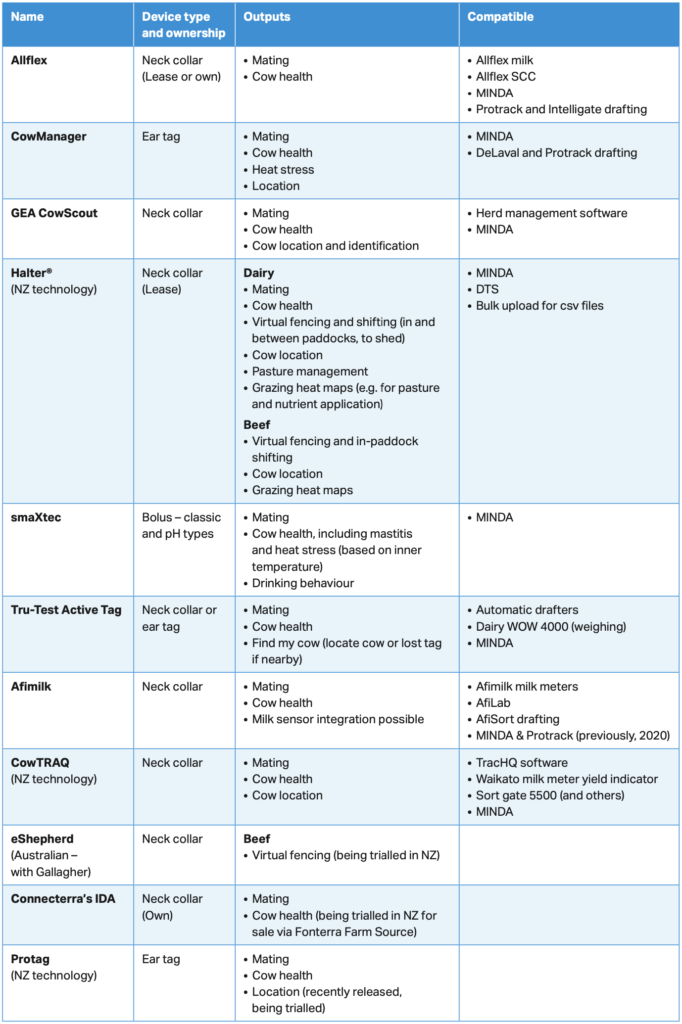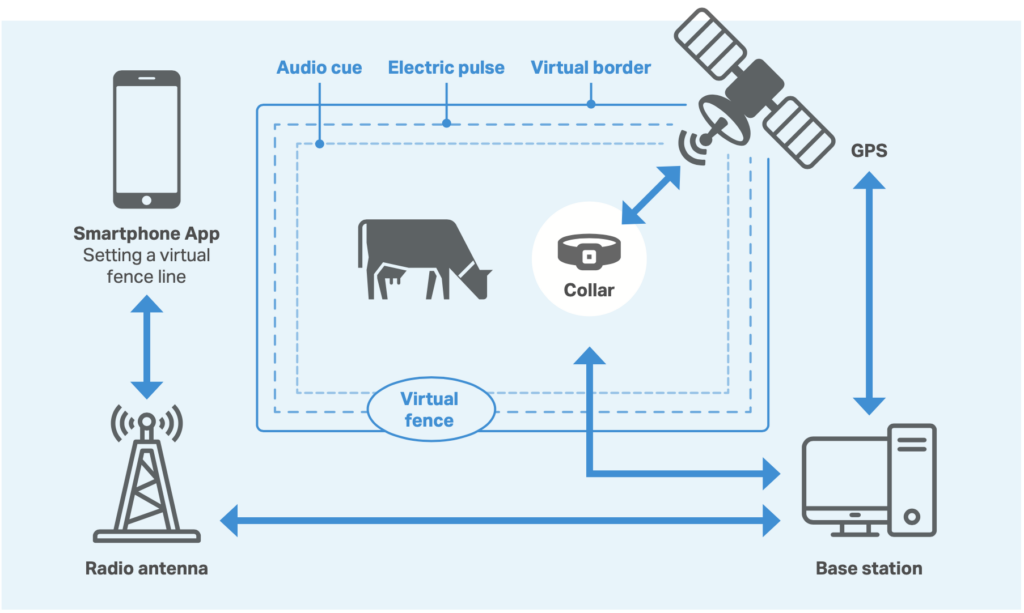Cow Collars Proving their Worth for Dairy Farmers
A recent study shows cow collars can be effective in improving reproductive performance, stock health and pasture management. If approved by regulators, they could also reduce compliance costs.
Researcher Liz Dooley admits to being sceptical about the utility of high-tech cow collars when she launched a project to help inform farmers’ decisions about whether to invest in the technology – before adding that she’s more positive about the collars now.
“It does look like they’re viable, particularly because they can improve pasture management (with virtual fencing) and pick up cows in heat, which is critical.”
Liz Dooley led a team of researchers who evaluated the benefits and costs, both tangible and intangible, associated with cow collar technologies to help farmers make informed, confident decisions about whether to adopt and implement them.
They investigated the range of collar technologies available, including ear tags and boluses, ranging in price from about $40 to $197/cow/year and interviewed 10 farmers using six different technologies. See Table 1 for a list of cow collar technologies.
Because of this considerable investment capital, the decision to adopt cow collar technology is not made lightly. Quantifiable information on benefits and costs of these technologies is limited and is usually provided by those selling the technology.
Of the 11 different technologies identified, eight are commercially available, with one (Halter) also offering virtual fencing capability (Figure 1).
The Halter collar is considerably more expensive than others in the market, meaning a trade-off between cost and features is something potential adopters must consider.

Cow collar evaluation
Why: To investigate the advantages and disadvantages of cow collar technology to the farm system and inform those considering adopting it.
Where: Case studies on one Manawatu and two mid-Canterbury dairy farms, and 10 interviews with farmers using six different technologies.
Who: Elizabeth (Liz) Dooley, Rachel Hammond, and Iona McCarthy.
What:
- Mating and labour were primary reasons for adopting collars.
- Eleven technologies were identified, with eight clearly being commercially available. Of these, only one offered virtual fencing capability (Halter).
- Collar technologies can be expensive, ranging from about $40 to $197/cow/year.
- Collars reduce the requirement for labour, particularly skilled labour, free up staff for other jobs and reduce costs associated with labour.
- Collars with virtual fencing had a number of additional benefits, which include managing critical source areas, pasture management, and to inform fertiliser use.
Benefits of collar technology
Interviews with farmers revealed their main drivers for investing in collars were for mating and to reduce labour requirements.
“I think they’re good if you employ staff because some don’t have the skills. That’s why it’s been picked up by quite a few people because it’s important to get your cows in-calf,” Dooley says.
Some new users took a cautious approach to using the devices for heat detection, but over time they learned to trust the technology.
“The onus is often on the owner or the manager to be in the shed over mating, but now some of them are getting so confident in the collar’s heat detection accuracy that next season they possibly won’t even be in the shed over mating.
“They use the tail paint or the buttons or whatever for the first year as well, and then after that they’ve found the app was just as effective at picking up cows so they’re confident in the app.
“In fact, by detecting a cow’s activity changes, some users report collars can out-perform the traditional methods of heat detection,” Dooley says.
“Some cows have silent heats and apparently that’s happening more often nowadays with the highly productive cows, so you can’t pick it up so easily. But you can see it on the app that there was activity a day or two beforehand – so when the app says so, she’s probably on heat.
Interviews with farmers revealed their main drivers for investing in collars were for mating and to reduce labour requirements.

“Some of the farmers were a bit cynical, but they mated her, and indeed she was in heat and she got in-calf.”
While reducing labour requirements was another driver, farmers reported that rather than reducing staff they were able to use staff time more effectively.
“They thought they would cut a labour unit but they don’t. The staff are getting all those other jobs done on the farm that didn’t used to get done, which is also probably going to improve things – and the workers are probably happier as well.”
Most collars in the study focused on heat detection and cow health (using rumination as a key measure). Sensors measure cow activity (accelerometer), and possibly temperature (via eartag or bolus), heart rate, pressure (for rumination).
Only the Halter collars offer virtual fencing, keeping cows where they’re put and sending a signal telling them to come in for milking, which adds up to considerable labour savings. But Dooley says one of the biggest advantages of the Halter virtual fencing capability is its pasture management.
“People who are using virtual fencing are getting significantly more pasture because you’re back – fencing behind the cows, which you can do at the push of a button, keeping cows off areas they’ve already grazed.
“If you’re having a damp day you can cut out a bit of the paddock you don’t want trampled and they’re just getting much better pasture quality because it hasn’t been trampled.”
The report concludes there is potential for these technologies to become increasingly used in the industry and integrated across the farm system.
Sensor and data capture technology is evolving rapidly, and ongoing data analysis and machine learning will improve algorithms and prediction over time. It’s likely to be relatively straightforward to add more sensors to cow collars in future. Integration with other precision agriculture technologies will expand their potential.
“Things evolve, don't they?”
Dooley’s initial scepticism has been replaced with an understanding of how useful this technology can be on-farm. If regulators accept the effectiveness of virtual fencing it could offer additional advantages, she says.
“If the technology becomes accepted it has the potential to save a lot of fencing costs or even [for farmers] to pay less for compliance if they can use the outputs to prove the cows weren’t in any waterways.”
While the study concentrated on dairy farming, virtual fencing is also an option for other farmers.
“If the technology becomes accepted it has the potential to save a lot of fencing costs or even [for farmers] to pay less for compliance if they can use the outputs to prove the cows weren’t in any waterways.”
For example, they could use virtual fencing to keep animals out of waterways on hill country that were previously impractical to fence because of the terrain.
“You could make a significant improvement there because you can’t get quite the same pasture quality you can on a dairy farm where they have rotational grazing and electric fences, so you’ve got quite a low utilisation rate.
“But if you virtually fence the rough areas, you could keep them on the bit of the hillside they don’t really like to eat, and when they come back next time it’ll be better pasture.”
The data the collars provide is now also being picked up by vets to help them advise their farmer clients.
They can analyse trends and use that to work with their clients.”
Dooley says some basic farms skills, like heat detection and pasture management, are already in short supply among new staff, so the collars fill that need.
“I think those skills (pasture and animal management) are probably not going to get any better if you bring in something like this. Things evolve, don’t they? People will become very skilled at using this and understanding the data and interpreting and reacting to that instead,” she says.
This article was first published in New Ground magazine, issue 4. All text is licensed for re-use under Creative Commons Attribution 4.0 International (CC BY 4.0)
Author
 View Our Strategy Document 2019 – 2024
View Our Strategy Document 2019 – 2024




Leave a Reply